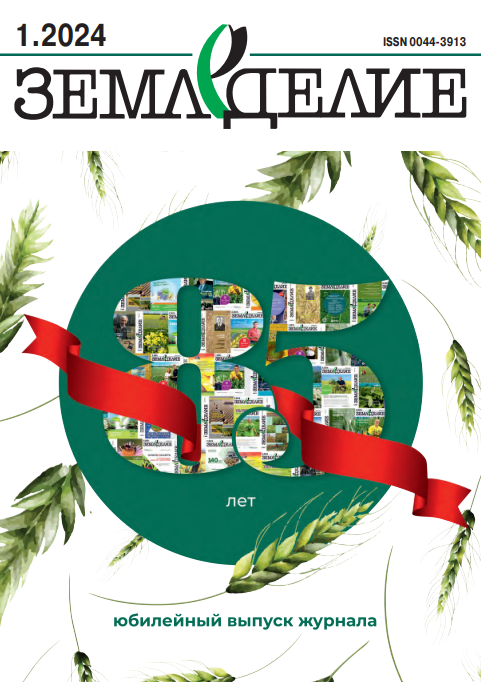Методология проектирования севооборотов и оптимальной структуры посевных площадей в адаптивно-ландшафтном земледелии (на примере Центрального Черноземья)
DOI: 10.24411/0044-3913-2018-10603
УДК 631.58:631.582
А. С. Акименко, доктор сельскохозяйственных наук, ведущий научный сотрудник (е-mail: Адрес электронной почты защищен от спам-ботов. Для просмотра адреса в вашем браузере должен быть включен Javascript.)
Всероссийский научно-исследовательский институт земледелия и защиты почв от эрозии, ул. Карла Маркса, 70б, Курск, 305021, Российская Федерация
Цель исследования – улучшение качества проектов для устойчивого производства продукции полеводства на основе анализа методов проектирования на предшествующих этапах развития систем земледелия и обширного экспериментального материала (собственного и по публикациям), полученного в многолетних стационарных опытах. Первоочередное требование к разработке названных проектов – анализ условий агроландшафта сельхозпредприятий. Их экспертиза посредством нормативных ограничений по степени эрозионной опасности и соответствию качества участков пашни требованиям полевых культур позволяет выявить возможные варианты специализации. Эти сведения, наряду с экспериментальными данными о месте и доле конкретных культур в севооборотах, используют и при составлении экологоэкономико-математической задачи для определения базисного варианта оптимальной (соответственно специализации) структуры посевных площадей, а также при рассмотрении вариантов территориальной организации системы севооборотов. Зависящие от последней целесообразные варианты схем севооборотов количественно оценивают на основе информационно-энергетического анализа. Последний базируется на закономерностях накопления посевами энергии в связи с расходом воды и выносом элементов минерального питания. При испарении посевами 1 мм (10 т/га) воды, обеспеченном необходимым выносом элементов минерального питания (не менее 0,295 кг N и 0,125 кг P2О5, около 0,3 кг К2О), в фитомассе запасается 0,567 ГДж энергии; количество энергии в товарной и побочной частях равно (в ГДж) сумме выноса (в кг) К2О с половиной выносов N и Р2О5. Точность прогноза урожайности культур и продуктивности севооборотов снижается во времени по мере несоблюдения закона возврата. В нашем стационарном опыте превышение продуктивности севооборотов со средним уровнем удобренности (12 т навоза и N37P37K37 на 1 га) относительно низкого (6 т навоза на 1 га севооборота) в пятой ротации увеличилось в 1,7 раза, по сравнению с первой, а точность прогнозных расчетов на слабоудобренном фоне ухудшалась в сторону завышения в 2,0…3,3 раза. Поэтому на заключительном этапе проектирования следует учитывать перспективу хозяйств по воспроизводству плодородия почв.
Ключевые слова: севообороты, структура посевных площадей, проектирова-ние, энергия, азот, гумус.
Для цитирования: Акименко А. С. Методология проектирования севооборотов и оптимальной структуры посевных площадей в адаптивно-ландшафтном земледелии (на примере Центрального Черноземья) // Земледелие. 2018. № 6. С. 11–14. DOI: 10.24411/0044-3913-2018-10603.
Methodology of Designing Crop Rotations and Optimal Structure of Sown Areas in Adaptive Landscape Agriculture (by the Example of the Central Chernozem Region)
A. S. Akimenko
All-Russian Research Institute of Farming and Soil Protection from Erosion, ul. Karla Marksa, 70 b, Kursk, 305021, Russian Federation
Abstract. The aim of the research was to improve the quality of projects for the stable output of field husbandry products on the basis of an analysis of design methods at the previous development stages of agriculture systems and extensive experimental material, obtained in long-term stationary tests. The first obligatory requirement for the development of these projects is an analysis of agro-landscape conditions of particular agricultural enterprises. The expert examination of the enterprises ensures the reveal of probable variants of specialization by means of the common standard limitations concerning to the risk level of erosion and compliance of quality of arable plots with the crop requirements. This information together with the experimental data about the place and share of certain crops in crop rotations is used when making an ecological, economic and mathematical task in order to determine a basic variant of the optimal (corresponding to the specialization) structure of crop areas, and when considering the alternatives of the territorial arrangement of a crop rotation system. Expedient alternatives of a crop rotation schemes, depending on the latter, are estimated on the basis of information and energy analysis, which is based on the regularities of energy accumulation by crops in the connection with the water flow rate and loss of mineral nutrients. Phytomass accumulates 0.567 GJ of energy at the evaporation of 1 mm of water (10 t/ha) by crops, provided with the necessary carrying out of elements of mineral nutrition (not less than 0.295 kg of nitrogen and 0.125 kg of phosphorus (in the form of P2O5), about 0.3 kg of potassium (in the form of K2O). The amount of energy in marketable and side parts is numerically equal to the sum of carrying out of potassium and a half carrying out of nitrogen and phosphorus. At the same time, the prediction accuracy of crop yield and crop rotation productivity depends on observance of the law of return (it decreases temporally as it is not observed). In our stationary test, the excess of productivity of a crop rotation with an average level of fertilization (12 t of manure and N37P37K37 per hectare) relatively to a low level (6 t of manure per 1 hectare of crop rotation area) increased 1.7 times in the fifth rotation in comparison with the first one. The accuracy of prognostic calculation worsened against a poor background 2.0–3.3 times (towards overstating). That is why at the final stage of designing the prospect of soil fertility reproduction should be taken into account.
Keywords: crop rotation; crop area structure; designing; energy; nitrogen; humus.
Author Details: A. S. Akimenko, D. Sc. (Agr.), leading research fellow (е-mail: Адрес электронной почты защищен от спам-ботов. Для просмотра адреса в вашем браузере должен быть включен Javascript.).
For citation: Akimenko A. S. Methodology of Designing Crop Rotations and Optimal Structure of Sown Areas in Adaptive Landscape Agriculture (by the Example of the Central Chernozem Region). Zemledelije. 2018. No. 6. Pp. 11–14 (in Russ.). DOI: 10.24411/0044-3913-2018-10603.










